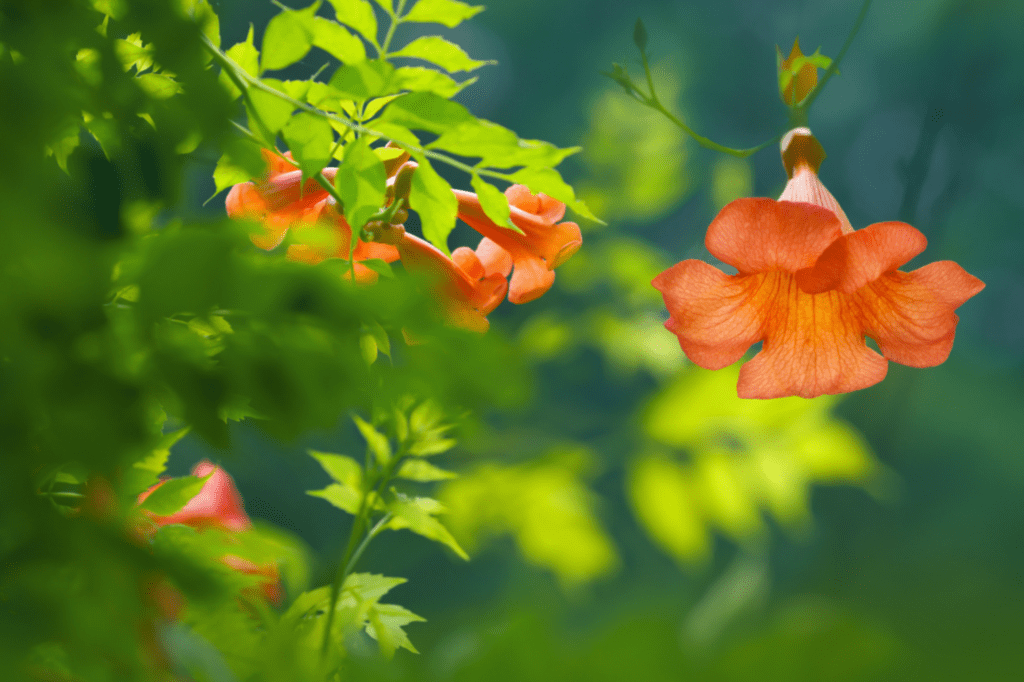If you are a trumpet vine owner, you know how disappointing it is when your vine doesn’t produce the vibrant blooms you hoped for. Trumpet vines are known for their stunning flowers, but they require proper care to reach their full blooming potential. In this guide, we will share essential tips and tricks to help your trumpet vine produce beautiful, colorful blooms.
Key Takeaways
- Proper care is crucial for trumpet vines to produce beautiful blooms.
- Pruning, fertilizing, and providing adequate sunlight and water are essential for trumpet vine care.
- Pests and diseases can hinder your vine’s ability to flower, so prompt action is necessary.
- Trumpet vines require proper trellis support to grow optimally and bloom vigorously.
- By understanding the trumpet vine’s flowering season, you can set realistic goals and enjoy blooms throughout the season.
Understanding Trumpet Vine Care
Trumpet vines are stunning flowering plants that can add a delightful touch to your garden. However, they require proper care and attention to produce their characteristic blooms.
Here are some essential care tips you need to keep in mind:
Pruning Techniques
Pruning is crucial for trumpet vines, especially if you want to encourage beautiful blooms. The best time to prune is during late winter or early spring, just before the new growth begins. You can cut back the previous year’s growth to around two to three buds to stimulate new growth and increase flowering.
Suitable Fertilizers
Trumpet vines require well-draining, fertile soil that is rich in nutrients. Adding organic compost or aged manure to the soil can significantly improve the soil quality. You can also use a balanced fertilizer in the spring to provide the necessary nutrients. Avoid using too much nitrogen, as it can lead to excessive foliage growth at the expense of blooming.
Ideal Growing Conditions
Trumpet vines love warm weather and thrive in full sun or partial shade. They prefer well-draining soil and can tolerate drought conditions once they are established. However, they require regular watering during the first few years of growth to ensure proper establishment.
By following these essential care tips, your trumpet vine will produce stunning blooms that will add a colorful touch to your garden.
Providing Adequate Sunlight and Water
Trumpet vines require a lot of sunlight, and typically, they need at least six hours of direct sun per day to thrive. When planting your vine, choose a location where it can receive the maximum amount of sunlight. If you notice that your trumpet vine is not blooming despite receiving ample sunlight, your plant may be getting too much shade. Trim any nearby tree branches or foliage that may be blocking the sunlight and hindering the plant’s growth.
It is also essential to ensure that your trumpet vine is receiving the appropriate amount of water to support its growth and blooming. Although trumpet vines are drought-tolerant, they still require consistent watering to produce healthy blooms. During hot and dry weather, your trumpet vine may require watering once a week to prevent dehydration. However, ensure you don’t overwater your vine, as it may lead to root rot and hinder its growth.
Dealing with Pests and Diseases
Your trumpet vine is vulnerable to various pests and diseases that can damage its leaves, stems, and flowers. By learning how to identify these issues and providing appropriate remedies, you can keep your trumpet vine healthy and blooming.
Common pests that can attack your trumpet vine include spider mites, aphids, caterpillars, and whiteflies. You can spot these pests by observing your plant closely and looking for signs of infestation, such as webs or holes in the leaves. To remove these pests, you can use natural remedies such as neem oil or insecticidal soap. If the infestation is severe, consider using a specialized pesticide, but be sure to follow instructions carefully.
Diseases that can affect your trumpet vine include powdery mildew, leaf spot, and root rot. These diseases can cause discoloration, wilting, and even death of your plant. To prevent these diseases, ensure proper drainage and avoid over-watering your trumpet vine. If you notice any symptoms of disease, remove affected leaves or stems and apply an appropriate fungicide. Be sure to follow the instructions carefully and avoid applying during periods of high humidity.
Providing Proper Trellis Support
Trumpet vines are vigorous climbers, and providing proper trellis support is crucial for their optimal growth and blooming. Without sufficient support, their heavy branches may fall, leading to damage or stunted growth. Fortunately, there are various trellis options and techniques you can use to keep your trumpet vine upright and strong.
If you are building or buying a trellis for your trumpet vine, make sure it is sturdy and durable enough to withstand strong winds and heavy rainfall. You may also consider using a trellis made of natural materials, such as wood, for a more organic look that complements your garden’s aesthetic.
When installing the trellis, ensure that it is securely anchored to the ground. If your trumpet vine is already growing and needs support, gently guide its branches onto the trellis and tie them in place using soft plant ties or twine. Avoid using wire or any material that may damage or cut into the branches.
As your trumpet vine continues to grow, make sure to check the trellis periodically and adjust the ties as needed to avoid any constrictions or excessive pressure on the branches. With proper trellis support, your trumpet vine will flourish and produce beautiful, vibrant blooms that will enhance the beauty of your garden.
Understanding Trumpet Vine’s Flowering Season
Trumpet vines have a specific flowering season that you should be aware of to maximize their blooming. Typically, these vines start to flower in late spring or early summer and continue flowering until the fall.
The flowering season can vary depending on the climate, temperature, and sun exposure in your area. In warmer regions, trumpet vines may flower earlier and continue blooming for a longer time.
To ensure your trumpet vine reaches its full potential for blooming, you should monitor the temperature and sun exposure in your area. If you live in a hotter area, you may want to provide some shade for your vine to prevent the flowers from drying out. On the other hand, if you live in a cooler area, you might want to place your vine in a sunny spot to help it flower.
Remember, the flowering season of your trumpet vine may vary each year, so it’s essential to adjust your care accordingly.
Conclusion
Congratulations, you now have all the essential information to encourage your trumpet vine to produce beautiful, vibrant blooms! Remember, proper care, suitable fertilizers, adequate sunlight, and watering practices are crucial for optimal growth and consistent flowering.
Be sure to address any pest or disease issues promptly, as they can hinder your trumpet vine’s ability to flower. And don’t forget to provide proper trellis support to help your trumpet vine grow successfully.
Finally, by understanding the trumpet vine’s flowering season, you can set realistic expectations and plan your garden effectively to enjoy its stunning blooms throughout the season.
With these tips and strategies, you can successfully encourage your trumpet vine to flower and enjoy its beauty for years to come. Happy gardening!
FAQ
Q: How do I encourage my trumpet vine to flower?
A: To encourage your trumpet vine to flower, you should provide proper care, including pruning techniques and suitable fertilizers. Ensure that the plant receives adequate sunlight and water, address any pest or disease issues promptly, and provide trellis support for optimal growth and blooming.
Q: Why isn’t my trumpet vine blooming?
A: There could be several reasons why your trumpet vine isn’t blooming. It could be due to inadequate sunlight, improper pruning, lack of suitable fertilizers, or pest and disease issues. Review your care routine and make necessary adjustments to encourage blooming.
Q: How much sunlight does a trumpet vine need?
A: Trumpet vines require full sun to thrive and produce vibrant blooms. Ideally, they should receive at least six to eight hours of direct sunlight daily. Ensure that you plant them in a location that gets ample sunlight throughout the day.
Q: How often should I water my trumpet vine?
A: Trumpet vines generally require moderate watering. Water them deeply once a week, allowing the soil to dry out slightly between waterings. Avoid overwatering, as it can lead to root rot and hinder blooming.
Q: What are common pests and diseases that affect trumpet vines?
A: Common pests that can affect trumpet vines include aphids, spider mites, and whiteflies. Disease issues may include powdery mildew and root rot. Regularly inspect your vine for signs of pests or diseases and take appropriate measures, such as using insecticidal soap or fungicides, to prevent or treat the issues.
Q: Should I provide trellis support for my trumpet vine?
A: Yes, providing trellis support is essential for trumpet vines. They are vigorous climbers that can reach significant heights. Without proper support, the vine’s growth can become disorganized, leading to reduced blooming. Install a sturdy trellis or support structure and guide the vine’s growth along it.
Q: When can I expect my trumpet vine to flower?
A: Trumpet vines typically flower during the summer months, from late spring to early fall. However, the exact flowering season may vary depending on factors such as climate and growing conditions. Be patient and ensure you provide optimal care to maximize blooming during the season.











